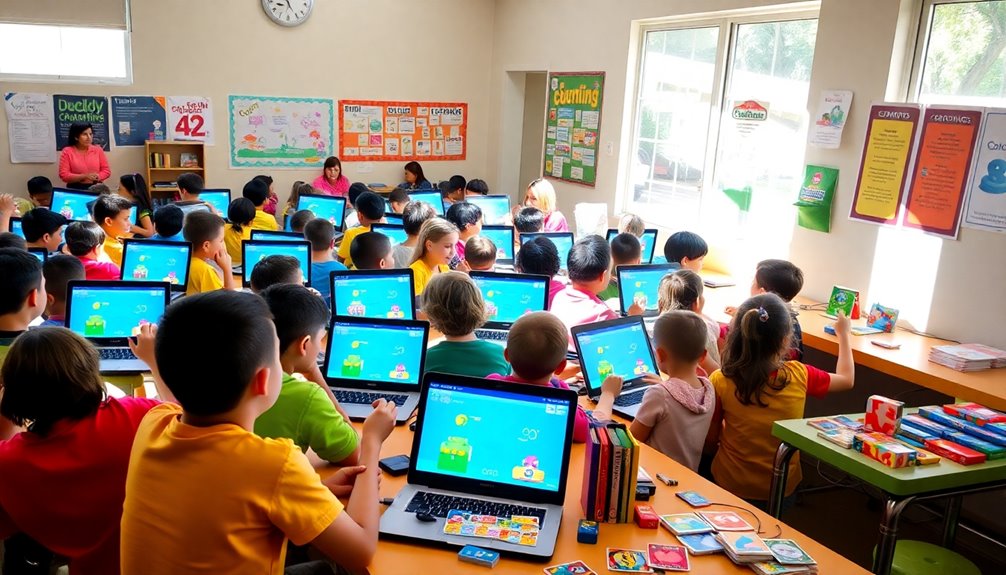If you're looking for fun and engaging coding games for kids, I recommend starting with the Learning Resources Code & Go Robot Mouse Activity Set, perfect for ages 4 and up. The Botley The Coding Robot sets are fantastic too, introducing coding through interactive play. For older kids, the Makeblock mBot Robot Kit combines electronics and programming. Each game enhances critical thinking while making learning enjoyable. Stick around to discover even more exciting options that inspire creativity!
Key Takeaways
- The Learning Resources Code & Go Robot Mouse Activity Set is perfect for ages 4+, promoting creativity and problem-solving through hands-on play.
- Botley The Coding Robot introduces coding in a screen-free environment, featuring interactive play with 45 pieces and coding cards for ages 5 and up.
- The Botley 2.0 Activity Set enhances coding education with 78 pieces and 16 interactions, adapting to various skill levels while ensuring screen-free fun.
- The Makeblock mBot Robot Kit combines electronics and programming for ages 8-12, allowing for remote control functionality and creative assembly with LEGO compatibility.
- Coding games develop critical thinking, fine motor skills, and problem-solving abilities, engaging children in STEM education through interactive and creative learning experiences.
Learning Resources Code & Go Robot Mouse Activity Set for Kids
The Learning Resources Code & Go Robot Mouse Activity Set is the perfect choice for kids aged 4 and up who are just starting their coding journey. This hands-on toy comes with 83 pieces, including maze grids, walls, and coding cards that spark creativity. I love how it promotes critical thinking and problem-solving skills as kids program Colby, the robot mouse. It's easy to assemble, and younger kids enjoy simply watching him move, while older kids dive deeper into coding tasks. Plus, it makes a fantastic gift for birthdays or holidays, fostering STEM learning in a fun, interactive way.
Best For: Kids aged 4 and up who are beginning their coding journey and enjoy hands-on learning experiences.
Pros:
- Promotes critical thinking and problem-solving skills through engaging coding activities.
- Easy to assemble and encourages creativity as children design their own mazes.
- Great as a gift for birthdays or holidays, making STEM learning fun and interactive.
Cons:
- Some users experienced issues with the mouse not rolling straight or wheels jamming.
- Younger children (3 years and below) may only be entertained by the mouse's movement, limiting engagement.
- Requires supervision during play to prevent potential damage to components.
Learning Resources Code & Go Robot Mouse Activity Set for Kids (Ages 4+, 83 Pieces)
Looking for an engaging way to introduce coding concepts to your little one? The Learning Resources Code & Go Robot Mouse Activity Set is perfect for kids aged 4 and up. With 83 pieces, including maze grids and coding cards, it encourages creativity and problem-solving. I love how my child builds mazes and programs Colby, the robot mouse, to find the cheese. It promotes critical thinking and fundamental coding skills, all while being screen-free! Plus, the sturdy design means it'll last through countless adventures. This set makes a fantastic gift for birthdays or holidays while making learning fun and interactive!
Best For: Kids aged 4 and up who are interested in learning coding concepts through interactive and creative play.
Pros:
- Encourages critical thinking and problem-solving skills through maze-building and programming.
- Screen-free activity that promotes STEM learning in a fun and engaging manner.
- Sturdy design ensures durability for repeated use and play.
Cons:
- Younger children (3 years and below) may not engage deeply with coding tasks.
- Some users reported issues with the mouse not rolling straight or wheels jamming.
- Requires supervision during play to prevent potential damage.
Learning Resources Botley The Coding Robot (45 Pieces, Ages 5+)
For young learners aged 5 and up, the Learning Resources Botley The Coding Robot stands out as an engaging introduction to coding concepts. This 45-piece activity set includes a remote programmer, detachable arms, and 42 coding cards that spark creativity and problem-solving. I love how Botley promotes STEM skills while keeping kids active and screen-free! It can follow commands, detect obstacles, and even navigate black-line paths. Setup is a breeze with just five AAA batteries. While it's perfect for individual play, consider getting two for group fun. Overall, Botley makes coding both fun and educational for kids!
Best For: Children aged 5-9 who are interested in learning coding concepts through interactive play.
Pros:
- Engaging and Fun: Children find Botley entertaining, making learning enjoyable.
- Promotes STEM Skills: Introduces coding and critical thinking in a screen-free environment.
- Easy Setup: Quick to get started with just five AAA batteries.
Cons:
- Object Detection Issues: Some users report challenges with the robot's ability to detect objects effectively.
- Line-Following Limitations: The line-following feature may struggle on carpeted surfaces.
- Not Ideal for Group Play: Best suited for individual use; purchasing two may be necessary for simultaneous play.
Learning Resources Botley The Coding Robot 2.0 Activity Set for Kids
Designed for children ages 5 and up, Botley The Coding Robot 2.0 Activity Set stands out as a fantastic choice for introducing young learners to the world of coding. With 78 pieces and 16 fun interactions, Botley transforms into various characters like trains and police cars, making learning exciting. I love that it offers screen-free fun, teaching kids coding without tablets. The set encourages critical thinking and adapts to different skill levels, thanks to its detailed guide. While some users faced minor issues, Botley remains a valuable investment for nurturing early STEM skills, making it perfect for gifts and educational play.
Best For: Botley The Coding Robot 2.0 Activity Set is best for children ages 5 and up who are interested in learning coding and STEM skills through interactive play.
Pros:
- Screen-free learning: Engages kids without the use of tablets or phones, promoting hands-on experience.
- Adaptable activities: Allows parents to customize the complexity based on their child's developmental stage.
- Encourages critical thinking: Fosters problem-solving skills and imagination through various coding interactions.
Cons:
- Potential defects: Some users have reported issues with non-responsiveness in the robot.
- Customer service concerns: There are mentions of poor customer service experiences when addressing product defects.
- Limited turning angles: Botley can only turn at 90 or 45 degrees, which may restrict certain play scenarios.
Makeblock mBot Robot Kit for Kids Ages 8-12
The Makeblock mBot Robot Kit stands out as an exceptional choice for kids aged 8-12 enthusiastic to plunge into the world of electronics and programming. With its engaging features, kids can learn coding through Scratch and Arduino while assembling the robot in just 15 minutes. I love how it doubles as a remote control car with cool functions like line-following and obstacle avoidance. Plus, it's compatible with over 100 electronic modules and LEGO parts, allowing endless creativity. The positive user feedback highlights its educational value, making it a fantastic gift for birthdays or special occasions.
Best For: The Makeblock mBot Robot Kit is best for kids ages 8-12 who are interested in learning electronics, robotics, and programming.
Pros:
- Encourages hands-on learning and creativity through coding and building projects.
- Easy assembly within 15 minutes, making it accessible for young learners.
- Compatible with various electronic modules and LEGO parts, enhancing versatility.
Cons:
- Some users reported challenges with software and documentation for programming.
- Battery requirements (not included) may be an inconvenience for some users.
- Age appropriateness may vary, with younger children needing more assistance.
Learning Resources STEM Explorers Pixel Art Challenge (402 Pieces)
Looking for a fun way to introduce your child to coding concepts? The Learning Resources STEM Explorers Pixel Art Challenge is an excellent choice! With 402 colorful pixel cubes, your child can create engaging 2-D and 3-D art while solving math and coding challenges. It's designed for kids aged 5 and up, promoting critical thinking and fine motor skills. Plus, the safe foam cubes guarantee worry-free play. I love how it keeps kids entertained for hours, whether at home or during family activities. This toy makes learning STEM concepts enjoyable and interactive—definitely a must-have for any young coder!
Best For: The Learning Resources STEM Explorers Pixel Art Challenge is best for children aged 5 and up who are interested in coding and creative problem-solving.
Pros:
- Engages children in STEM learning through interactive and creative activities.
- Enhances critical thinking, fine motor skills, and problem-solving abilities.
- Safe foam cubes prevent choking hazards, making it suitable for younger children.
Cons:
- Some users find the cubes to be flimsy and difficult to place accurately.
- There is a desire for additional boards to facilitate collaborative play.
- Concerns about the durability of foam cubes have been raised by some customers.
ELECFREAKS Retro Coding Arcade for Microsoft Makecode
For kids enthusiastic to plunge into the world of programming, the ELECFREAKS Retro Coding Arcade serves as an excellent entry point. This DIY handheld game console lets children create their own games using block programming or Python, which is a fantastic way to learn coding. With its 2.4-inch screen, built-in sensors, and user-friendly controls, it offers an engaging experience. I appreciate the rich tutorial resources available on the MakeCode website, making it easier for kids to develop their skills. Although some users noted minor issues with battery life and resolution, the overall feedback is quite positive.
Best For: Kids aged 8 and up who are enthusiastic about learning programming through game creation.
Pros:
- User-friendly: Easy to use with block programming and Python, making it accessible for beginners.
- Interactive learning: Engages children in STEM education through hands-on game development.
- Customizable: Allows kids to create unique games with various roles, sceneries, and plots.
Cons:
- Battery life concerns: Some users reported limitations in battery performance during extended play.
- Resolution discrepancies: Users have noted differences between advertised and actual screen resolution.
- Complex programming limitations: Some users experienced challenges with advanced coding functionalities.
Think Fun Hacker Cybersecurity Coding Game and STEM Toy for Ages 10
If you're searching for an engaging way to introduce kids aged 10 and up to the world of coding and cybersecurity, Think Fun's Hacker game stands out. This game includes a variety of components like movement tiles, agent tokens, and a challenge booklet with 120 progressively difficult puzzles. It promotes critical thinking and problem-solving skills while making learning fun. The high-quality materials and clear instructions guarantee kids can dive right in. With a solid customer rating of 4.4 stars, it's clear that players appreciate the challenge it offers, making it a fantastic STEM toy for young aspiring coders.
Best For: Kids aged 10 and up who are interested in coding and cybersecurity and enjoy solving challenging puzzles.
Pros:
- Engaging Gameplay: Offers 120 challenges that promote critical thinking and problem-solving skills.
- High-Quality Components: Made by ThinkFun, ensuring durability and a great user experience.
- Clear Instructions: Comes with a comprehensive manual that allows kids to start playing quickly.
Cons:
- Complexity for Younger Players: Some challenges may be too difficult for younger children or those without prior coding experience.
- Requires Peer Interaction: May be less enjoyable for solo players or those without friends to collaborate with.
- Potential Learning Curve: Kids might need time to fully grasp the programming principles introduced in the game.
Playz My First Coding & Computer Science Kit
The Playz My First Coding & Computer Science Kit stands out as an ideal choice for kids aged 6 to 12 who are enthusiastic to explore the fascinating world of coding and computer science. It's packed with engaging activities like creating binary necklaces and solving mystery mazes, all without needing a computer. With over 30 tools and a colorful lab guide, learning becomes hands-on and fun. I love how it promotes critical thinking and fine motor skills. Plus, the positive feedback from other parents reassures me that kids really enjoy these projects. It's a fantastic way to spark interest in STEM!
Best For: Kids aged 6 to 12 who are eager to learn about coding and computer science through hands-on activities.
Pros:
- Engaging and interactive projects that foster creativity and critical thinking.
- Includes over 30 tools and a colorful lab guide for easy and fun learning experiences.
- Positive customer feedback highlights the enjoyment and educational value of the kit.
Cons:
- Some users report challenges in locating specific instructions for activities.
- May require adult supervision or assistance for younger children.
- Limited appeal for older children or those with advanced coding knowledge.
AI Learners Board Game for Kids Age 6
Coder Mindz stands out as a fantastic choice for kids aged 6 and up looking to plunge into the world of AI and coding. This first-ever board game introduces essential concepts like Image Recognition and Algorithms in a fun way. With three modes of play and two difficulty levels, it keeps both beginners and advanced players engaged. I love how players program robots using cards to navigate challenges, sparking laughter and strategic thinking. Plus, it's been adopted in over 600 schools! The high-quality design and positive feedback make it a must-have for homes and classrooms alike.
Best For: Kids aged 6 and up who are interested in learning about AI and coding through interactive play.
Pros:
- Engaging gameplay that fosters strategic thinking and teamwork.
- High-quality materials and design, ensuring durability and long-lasting use.
- Free downloadable curriculum available, enhancing educational value for schools and parents.
Cons:
- Some minor errors reported in card instructions may cause confusion.
- Complexity may be challenging for younger players without adult assistance.
- Limited availability of the free curriculum after the promotional period.
Learning Resources Code & Go Robot Mouse STEM Toy for Kids
Designed for kids aged four and up, the Learning Resources Code & Go Robot Mouse STEM Toy stands out as an engaging introduction to coding concepts. With 31 pieces, this programmable mouse lights up, makes sounds, and can be controlled using simple push-button coding cards. It encourages critical thinking and problem-solving skills while kids navigate obstacle courses or solve math problems. I love how it's durable enough for rough play, making it perfect for classroom or home use. Plus, it's an ideal gift for birthdays or holidays, ensuring hours of fun while learning essential STEM skills!
Best For: The Learning Resources Code & Go Robot Mouse STEM Toy is best for children aged 4 and up who are interested in exploring coding concepts through interactive play. With its engaging design and hands-on activities, this toy encourages problem-solving and critical thinking skills while providing a fun introduction to programming. Ideal for both individual play and group activities, it fosters collaboration and communication among young learners. As one of the best STEM toys for kids, it lays a solid foundation for future learning in science, technology, engineering, and mathematics. In addition to its educational benefits, the Learning Resources Code & Go Robot Mouse STEM Toy also features colorful and interactive components that captivate children’s attention and spark their creativity. By integrating coding into playtime, it helps young minds develop essential skills in a fun and engaging way, making it one of the best STEM toys for kids. As they navigate the challenges presented by the robot mouse, children gain confidence in their abilities and build a strong interest in STEM fields that can last a lifetime.
Pros:
- Engaging learning experience: Encourages critical thinking and problem-solving skills through fun, hands-on activities.
- Durable design: Built to withstand rough handling, making it suitable for classroom and home use.
- Versatile applications: Can be used for various educational purposes, including coding practices and math problem-solving.
Cons:
- Batteries not included: Requires 3 AAA batteries, which may be inconvenient for some users.
- Limited advanced features: While great for beginners, it may not offer enough complexity for older children interested in more advanced coding concepts.
- Size limitations: The small size may not be ideal for larger play areas or for use with multiple children at once.
PlayShifu Plugo Coding Kit – Interactive Block-Based Coding Games for Kids Ages 4-10
For young learners aged 4-10, the PlayShifu Plugo Coding Kit stands out as an engaging introduction to coding. This interactive kit uses block-based games to teach coding fundamentals through fun puzzles and challenges. With over 200 levels across three games, kids develop essential STEM skills while enhancing their problem-solving and analytical thinking. The kit includes 33 coding tiles, a gamepad, and a flash drive, all designed to work seamlessly with compatible devices. Parents rave about its ease of use and educational value, making it a fantastic choice for family bonding and learning together. It's definitely a must-have for curious minds!
Best For: The PlayShifu Plugo Coding Kit is best for children aged 4-10 who are eager to learn coding fundamentals through interactive play.
Pros:
- Engaging gameplay with captivating characters that motivate children.
- Develops essential STEM skills through adaptive challenges and over 200 levels.
- User-friendly setup, making it easy for parents and children to start learning together.
Cons:
- Some users have reported connectivity issues with certain games.
- Occasional glitches may occur during gameplay, affecting the experience.
- Not compatible with Amazon Fire devices, limiting accessibility for some users.
Educational Insights PYXEL Coding Robots for Kids
Looking for an engaging way to introduce your child to coding? The Educational Insights PYXEL Coding Robot is a fantastic choice! Designed for kids aged 8 to 14, it uses Blockly and Python, making it perfect for beginners and those ready for a challenge. With built-in tutorials, kids can start coding within minutes, and there's no need for internet access. PYXEL responds to touch and sound, offering an interactive experience. While some users report connectivity issues, many appreciate its educational value and ease of use. It's a great way to spark curiosity and creativity in coding!
Best For: The Educational Insights PYXEL Coding Robot is best for children aged 8 to 14 who are interested in learning coding through interactive play.
Pros:
- Encourages STEM learning through hands-on coding experience.
- Supports both Blockly and Python, catering to various skill levels.
- Easy setup with built-in tutorials allows quick start without needing internet access.
Cons:
- Some users experience connectivity issues and quality control problems.
- Mixed compatibility with certain devices, particularly tablets.
- Customer service responsiveness has been noted as lacking in some cases.
Snap Circuits Teach Tech Mech 5, Mechanical Coding Robot
The Snap Circuits Teach Tech Mech 5 Mechanical Coding Robot is perfect for budding engineers aged 10 and up who crave hands-on learning experiences. This entry-level STEM coding robot lets kids explore mechanical engineering and coding basics through fun missions. By snapping coding buttons onto the coding wheel, they can make the robot throw, lift, kick, draw, and move in different directions. I love that it promotes creativity and problem-solving skills while keeping learning engaging. With a rating of 4.5 stars and the ability to integrate with other Snap Circuit sets, it's a fantastic way to spark a child's interest in technology!
Best For: The Snap Circuits Teach Tech Mech 5 is best for aspiring engineers aged 10 and up who enjoy hands-on learning in STEM fields.
Pros:
- Encourages creativity and problem-solving skills through engaging missions.
- High educational value with the ability to integrate with other Snap Circuit sets.
- Positive customer feedback, with a solid rating of 4.5 out of 5 stars.
Cons:
- Assembly can be complex due to numerous small parts, requiring adult supervision.
- Some users find the plastic components to be fragile.
- The need for tools like snips and small screwdrivers may deter some users.
The Learning Journey Play It! Hop to It Coding Game for Kids
Parents seeking an engaging way to introduce coding concepts to their little ones will find the Learning Journey Play It! Hop to It Coding Game perfect. This fun game teaches spatial awareness and basic coding through colorful lily pads. Kids navigate a frog, learning sequences while enhancing their problem-solving skills. Plus, it encourages cooperation as they take turns and follow directions. The durable game cards and vibrant board keep children interested while they match letters and recognize shapes. With positive feedback from families, this award-winning game boosts confidence and makes learning a blast for everyone involved!
Best For: Parents looking to introduce coding concepts and enhance problem-solving skills in young children through a fun and interactive game.
Pros:
- Promotes cooperation and social skills as children take turns and follow directions.
- Engaging game design with colorful components that capture children's attention.
- Supports various developmental skills while providing a fun learning experience.
Cons:
- May require adult supervision for younger children to ensure understanding of game rules.
- Limited to basic coding concepts, which may not be sufficient for older kids interested in more advanced coding.
- Some families may find the game repetitive after multiple plays, reducing engagement over time.
Factors to Consider When Choosing Coding Games for Kids

When picking coding games for kids, I think it's crucial to evaluate factors like age appropriateness and educational value. It's also worth looking into screen-free options and how engaging the games are for young learners. Finally, understanding the complexity levels can really help match the game to your child's skill set.
Age Appropriateness
How can you guarantee the coding game you choose is right for your child? First, check the recommended age range provided by the manufacturer. This guarantees the content and complexity align with your child's developmental stage. For younger kids, like those aged 4+, focus on games that teach foundational concepts like sequencing and problem-solving. If your child is 8 or older, look for games that introduce advanced programming concepts through engaging challenges. Games catering to a wide age range, such as 6-12, can also enhance collaborative play among siblings or friends. Ultimately, it's crucial to match the game's difficulty level with your child's experience to keep them engaged without leading to frustration or boredom.
Educational Value
Choosing a coding game that offers real educational value is essential for fostering your child's interest in STEM skills. I look for games that promote critical thinking, problem-solving, and analytical abilities through interactive play. It's important that the game incorporates foundational coding concepts like sequencing and logical reasoning to strengthen their understanding of programming fundamentals. Engaging gameplay with challenges and adaptive levels keeps kids motivated, helping them push through difficulties while learning essential skills. I also appreciate games that integrate hands-on activities and real-world applications, which spark creativity and make learning enjoyable. Finally, ensuring the game is age-appropriate and caters to varying skill levels maximizes educational impact and keeps my child engaged as they progress.
Screen-Free Options
While many coding games involve screens, I find that screen-free options offer a revitalizing alternative that encourages hands-on learning. These games allow kids to engage directly with physical components, sparking creativity and imagination. I love how they promote critical thinking and problem-solving skills through interactive play, enabling children to grasp coding concepts without the distractions of screens. Many of these toys use visual coding systems, making sequencing and programming fundamentals intuitive and accessible. Plus, manipulating pieces or building structures enhances fine motor skills. The absence of screens also encourages social interaction, as kids collaborate to solve challenges and achieve shared goals. It's a fantastic way to combine learning and play in a meaningful way!
User Engagement
When it comes to selecting coding games for kids, engaging them effectively is essential for fostering a love of learning. I've found that interactive and hands-on activities really capture their attention, allowing them to immerse themselves in problem-solving and critical thinking. Games that weave in storytelling and adaptive challenges keep kids motivated as they explore different levels. Visually appealing elements like colorful boards and cards also draw them in, making the experience more inviting. Plus, incorporating feedback mechanisms—like rewards for achievements—reinforces learning and encourages ongoing participation. Finally, games promoting cooperative play enhance engagement, as children learn to communicate and collaborate with peers, all while developing valuable coding skills. These factors truly make a difference in their learning journey.
Complexity Levels
Steering through the world of coding games for kids can be tricky, especially since the complexity levels vary considerably. When I select a game, I pay close attention to the recommended age range. Some games are perfect for younger kids, while others plunge into advanced concepts suited for older ones. I also look for games that offer different difficulty levels to keep my child engaged and challenged as they progress. Adaptive challenges are a must—they guarantee the learning remains suitable for my child's developmental stage. Finally, I consider the types of coding concepts introduced. Basic sequencing is great for beginners, but older kids benefit from learning about loops and functions. Games that allow mixed-age play can also enhance collaboration and support.
Hands-On Activities
Hands-on coding activities can transform learning into an exciting adventure for kids. I've seen how these games encourage active engagement, allowing children to grasp coding concepts through tangible interactions. Many coding toys use blocks, cards, and robots, giving kids the chance to manipulate pieces and solve problems physically. Activities, like building mazes or programming sequences, spark critical thinking and problem-solving skills as they tackle challenges playfully. The colorful, interactive elements not only enhance fine motor skills but also boost creativity and spatial awareness. Plus, research shows that hands-on experiences improve retention and encourage collaboration when kids work together. I can't stress enough how these engaging activities make learning both enjoyable and effective for young coders!
Durability and Maintenance
Considering durability and maintenance is essential when choosing coding games for kids. I look for sturdy designs that can handle rough play, ensuring the toy lasts longer. It’s important to check how easy it is to clean the game, as some components may jam or fail without proper care. I’ve noticed that parents often recommend supervising play, highlighting the need for robust construction in these toys. Additionally, the ability to replace or repair parts can enhance the game’s value, making it more sustainable for our family. I appreciate products that are easy to assemble and disassemble, which simplifies maintenance and keeps my kids engaged by allowing for versatile play scenarios. Furthermore, I find that incorporating educational elements into these games enhances their appeal, as they foster creativity while teaching essential skills. Some of the best building toys for kids provide various ways to approach problem-solving, encouraging children to think critically and collaborate with peers. When a game can grow with my child’s interests and abilities, it not only maximizes its longevity but also ensures we get the most value and enjoyment out of it. Moreover, I believe that incorporating feedback from my children about their preferences can significantly impact our choices. Engaging them in the decision-making process ensures they remain enthusiastic about the toys, leading to more meaningful playtime experiences. By carefully selecting from the best building toys for kids, we can support their development while keeping the fun factor alive, making every play session both educational and enjoyable.
Budget Considerations
When I set out to find the best coding games for kids, budgeting plays an essential role in my decision-making process. I always start by setting a price range that matches my financial situation while ensuring quality. Coding games can range from $20 to over $100, so knowing my budget helps narrow down options without overspending. I focus on games that offer high educational value for their price, making sure my investment benefits my child's learning. I've found that some budget-friendly games provide similar advantages as pricier ones, so I compare features and reviews. Additionally, I consider the long-term value; a higher initial cost might lead to extended use, reducing the overall cost per use.
Frequently Asked Questions
What Age Group Is Best Suited for Coding Games?
I believe coding games are best suited for kids aged 6 to 12. At this age, they're curious and keen to learn, which makes it a perfect time to introduce coding concepts. I've noticed that younger kids grasp the basics quickly through interactive play, while older kids can tackle more complex challenges. Finding the right game for their age can spark a lasting interest in technology and problem-solving skills.
How Can Coding Games Improve Problem-Solving Skills?
Imagine a knight maneuvering through a maze to rescue a princess. That's how coding games can boost problem-solving skills. I've seen kids tackle challenges by breaking them down into smaller tasks, much like strategizing in a quest. They learn to think critically, anticipate obstacles, and find creative solutions. Each level they conquer builds their confidence and sharpens their ability to approach real-world problems, turning them into little heroes of logic and creativity.
Are Coding Games Available in Different Languages?
Absolutely, coding games are available in various languages! I've come across many platforms that offer games in languages like Python, JavaScript, and even Scratch. These options not only cater to different age groups but also let kids explore programming in their preferred language. It's exciting to see how these games can adapt, making it easier for everyone to grasp coding concepts. If you're curious, I can suggest some that I've personally enjoyed!
Can Coding Games Be Played Offline?
Absolutely, many coding games can be played offline! I've found that some of my favorite coding games don't require an internet connection, which is great for when I'm traveling or in areas with limited connectivity. These games often come with downloadable versions, so I can still practice coding without being online. It's a fantastic way to keep learning and having fun, even when I can't access the web!
How Do I Assess My Child's Progress in Coding Games?
I assess my child's progress in coding games by regularly checking their completed levels and tasks. I also ask them to explain what they've learned and how they solved challenges. Observing their problem-solving skills and creativity during gameplay helps me see their growth. Additionally, I encourage them to share their favorite projects, which gives me insight into their interests and strengths. It's a fun way to stay engaged in their learning journey!
Conclusion
To summarize, finding the right coding game for your child can truly transform their learning experience into something enjoyable and engaging. With so many fantastic options available, it's easy to spark their interest in coding and problem-solving. So, why not take the plunge and choose a game that fits your child's age and interests? You'll not only be fostering their skills but also creating lasting memories together. Happy coding!























